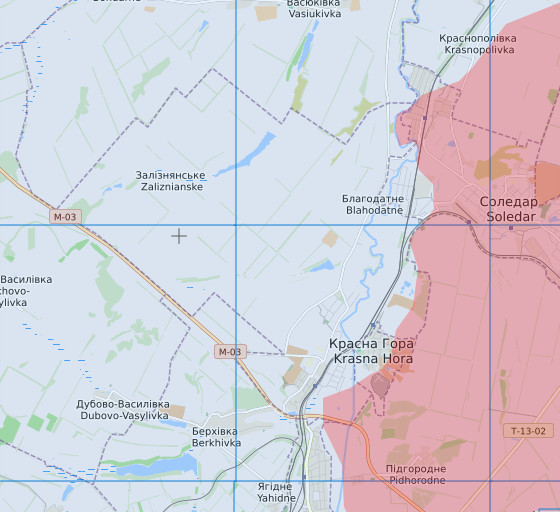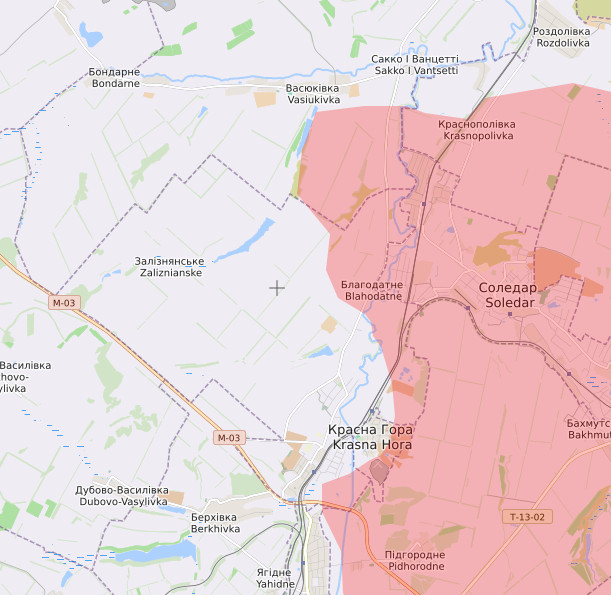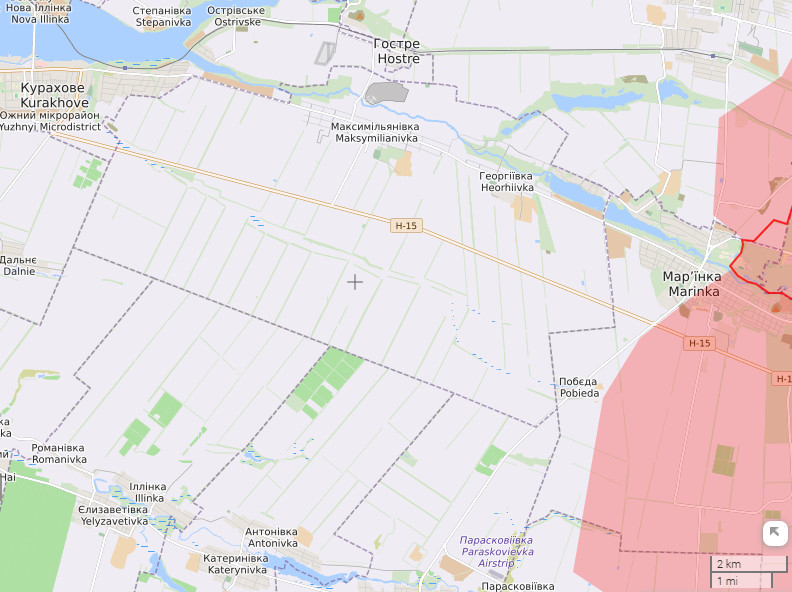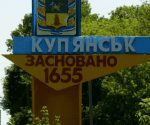The Russian Offensive
The Russian Ministry of Defence has been using the word “offensive” in its daily briefings to describe the activity of its forces in the northern section of the front line of its Special Military Operation since at least December 12th, which is when the author referred to it doing so in the article, Charted: Russian Activity In The Kupyansk And Krasny Liman Directions In December Thus Far. Indeed, an article was published at this site in late November entitled, The Russian Winter Campaign Has Evidently Already Started (?), and it noted the Russian movement that has lately proven to have been the early moments of an ongoing operation that has overtaken Soledar, and has developed in places beyond the Bakhmutovka River and the T0513 Seversk to Artyomovsk road so that it in its current standing is in the process of liberating Razdolovka, Blagodatnoye, and Krasnopolye in a north-westwards bloom to envelope Seversk, and in the environs of Ivanivskoye and Chasiv Yar in a southern prong around Artyomovsk.
This site also told its readership (also as early as November 2022, and most recently at the start of January) to pay attention to the “southern Donetsk direction” because it was noted that here was where the Russians would deny the pre-publicised and much vaunted supposed Ukrainian “Zaporozhe offensive”, and also where the Russians themselves could launch their own operation to liberate territory now officially part of the Russian Federation. As it now happens, the Russian MoD has, for several days, been talking about the activity of its forces in the newly coined “Zaporozhe direction” using the word “offensive”.
It’s quite clear that the Russians are conducting a joined-up offensive in several places along the line of contact, and naturally there is much denial in certain places where the insisted-upon narrative is supposed to tell of stalemate as an explanation for Ukrainian weakness. Take the UK Ministry of Defence, for instance, which in recent days issued the following:
Overall, the conflict is in a state of deadlock. However, there is a realistic possibility of local Russian advances around Bakhmut.
This, incidentally, appears to act as a guideline for the English-language, “pro-Russian”, geopolitical analysis alternative media, which – because it is controlled opposition – is studiously avoiding the subject of a current Russian offensive, but retaining its reputations (they all hope) by promising some huge “big arrow” offensive at some unknown point in the future. In the meantime, it (that is, the alternative media that the author can just about stand to look at) doesn’t attempt to disabuse its audience that the Russians and Ukrainians are not in fact existing in a state of frustrated equilibrium.
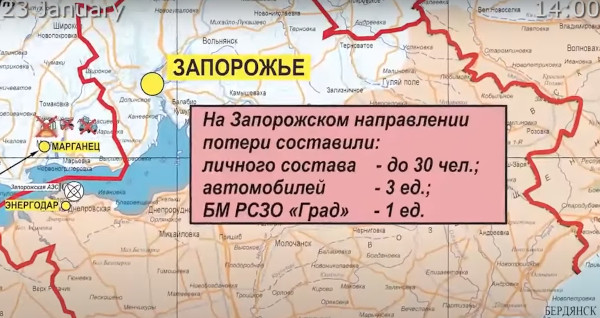
On 23rd January, the Russian MoD produced this map. To have the annotation totally obscuring the depiction of the front is unusual. Nothing indicates a desire to preserve some operational security than this (yes, the Russians can always falsify their maps to mislead [and appear to have done so], but this is quite the statement. Social media OSINT-mongery – who must be citing Ukrainian friends – say that the Russian have made other certain gains in the Zaporozhe direction. The Russians themselves have only confirmed the liberation of Lobkovoye.
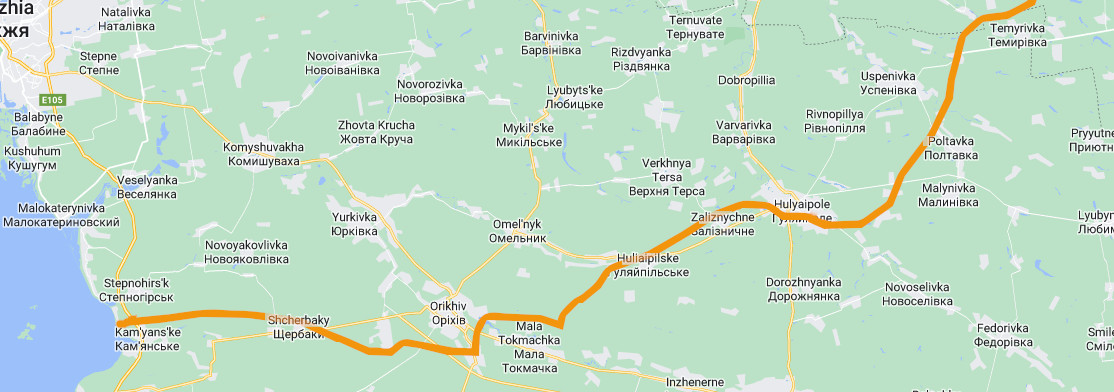
[Click to enlarge] On 22nd January, when providing some detail about “offensive operations… [to take] more advantageous lines and positions”, the Russian MoD listed an attack near Stepnogorsk (Stepnohirs’k), and Prechistovka, which is on the north-east flank of Orikhov (Orikiv) at the junction to the road to “Omel’nyk”. If the Russians are actually at these places, then they have advanced a good mile and half to be there.
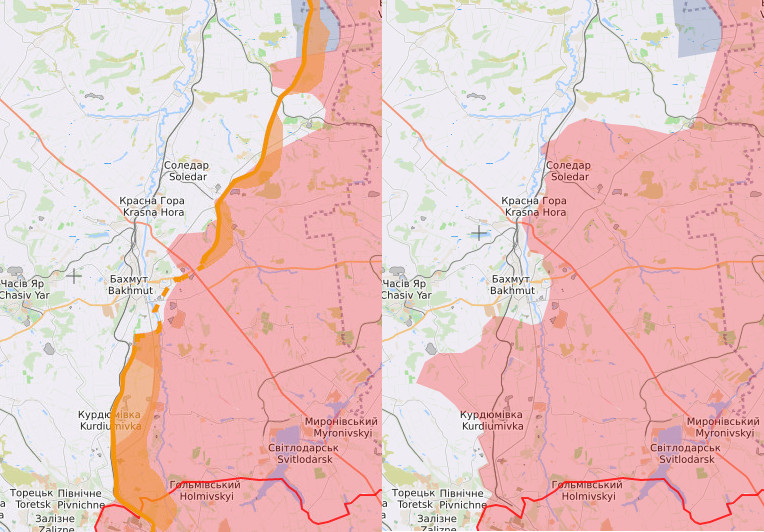
[Click to enlarge] On the left, Russian movement noted in the article The Russian Winter Campaign Has Evidently Already Started (?) (November 26th). On the right, the situation on January 24th. The Russian positions (now approximately, but not uniformly 4 miles further west), not just in the north but in every part of this sector, are actually very likely more well developed than liveuamap.com would care to admit at any time.
As the reader might well be aware, there has lately been something of a will-they-won’t-they saga surrounding Berlin’s donation of Leopard 2 tanks to the Armed Forces of Ukraine. As things stand (or so it appears), permission has been given (according to terms of purchase, evidently) to other countries (i.e. Poland, the Czech Republic is not going to make sacrifice) to donate the ones that belong to them. Germany is also sending 14, making 28 altogether, on the basis (as far as it can be made out) of the US sending 30-50 M1A1 Abrams tanks. These tanks, of course, do not constitute said latest package of weaponry on their own. A much broader one has been collected together with offerings from various NATO members – and Sweden. As far as the author has been able to confirm, the Ukrainians can expect to have sent to them the following:
158 tanks, including 90 T-72s (some of which were Moroccan owned and in the Czech Republic for refurbishment), not including whatever the US will send, ~600 armoured/protected vehicles, 190 Infantry Fighting Vehicles, 450 armoured personnel carriers, ~100 self-propelled artillery/anti-tank guns, and ~60 towed howitzers, along with a number of “anti-aircraft measures”, principally 115 Toyotas pickups fitted with a 14.5mm anti-aircraft twin gun, various air-defence missiles, and guns.
Now, let us revisit the FBEL article, The Offensive That Isn’t On 17th December: Russian Activity In The Kupyansk And Krasny Liman Directions, and its opening paragraph:
…the Ukrainians [are] essentially admit[ting] what the Russians have done to their standing army, and also… to the “million man” army so that they must now beg… for “300 tanks, 600-700 infantry fighting vehicles, [and] 500 Howitzers”… and “a reliable air defence system”.
This, as it was explained at the time, was for continuing the UK/US plan that had run out of steam in Kharkov: a full account is given in the article introduced immediately above, so no need to go over it again. Suffice to say, the above list of requirements, principally outlined by Valery Zaluzhny, the Commander-in-Chief of Ukrainian forces, was for a movement to the coasts of Zaporozhe and Donetsk in the same vein as there had been in Kherson and Kharkov where the objective was to take territory at the expense of very high casualty figures, taking advantage of the high artillery-to-infantry/tank ratio according to Russia’s system of warfare whereby the Russians would retire their mobile elements to allow the Ukrainians to come onto their guns. Just because the Ukrainians have used and will use vehicles in these operations, they are no less ones that employ the Human Wave doctrine.
And because the Ukrainians and their masters, in the plans they envision for the Spring, merely want to get their forces to a target at any cost, rushing through and trying to overwhelm and isolate inferiorly numbered opposition as they go (to date a thing actually not achieved by the Ukrainians), the essential requirement for this new package of weaponry would be vehicles with wheels (or tracks), an engine, steering, and in most cases space for passengers – and that they be in a large quantity so that some survive the mad dash.
This is why it’s a pointless exercise to compare the merits of Russian and US main battle tanks, for instance, to try and explain how future events (as the anti-Russian axis has plans for them) will pan out. It is for the exact reason that Leopard 2 tanks will be put (by the UK and US planners who are also their military-industrial competitors) in the vanguard of a rush-and-push to draw Russian fire and be destroyed that the Germans have been so reluctant to part with them. Reputations for further sales are at stake.
And, again, it should be self-evident why the anti-Russian axis does say that Artyomovsk is irrelevant – because the plan is still to cause Putin to suffer a political upset caused by the Russians being turfed out of the likes Mariupol and Melitopol.
Unfortunately, however, the anti-Russian axis appears to believe its own propaganda – that which declares that Russia has as much a problem as Ukraine is taking an initiative through the winter. On the contrary, the Russians are on the move, and causing more problems for the anti-Russian axis than not actually being able to deliver Zaluzhny’s shopping list; in fact, let’s deal with that first.
Leaping out is the woeful inadequacy in terms of artillery. Although in another recent FBEL article, this chronic lacking was stated as being especially a problem for a Ukrainian defensive posture (“when there is a reliance on Human Wave attack… then having artillery is not necessarily a great necessity”), it’s not that simple, because artillery – at least as the Russians use it in their integrated system – is a measure against one’s own assets being destroyed, whatever the context. And as we look through the list, while the number of tanks and IFVs (with which to punch holes in defences, we might suppose, in the minds of UK/US planners) are not in the quantities asked for, we can see that there are hundreds of less heavily armed vehicles by which to transport bodies. The M1117 “Armored Security Vehicle”, for instance, of which the US is to give 250 instances, is armed with machine guns and grenade launcher. In one of its variations it crews two people, and carries eight passengers. It has a maximum speed of 63 mph. This is what it’s all about.
The concept that started to be introduced in a previous paragraph, however, is that the anti-Russian axis has a great difficulty to overcome, namely the Russian offensive. If we, who write and read this article know Ukrainian plans for the Spring – their one-dimension rendering them so predictable – then so do the Russians. If the Russians are not fools – and there’s no evidence to suggest they are – Ukrainian plans are going to be accounted for, whether in terms of their being reacted to or negated. The former option is the author’s least preferred, but it is a possibility. However, this time the Ukrainians will not meet a foe who is acting advantageously by retiring in front of them. Russian defences have been built in Zaporozhe, implying the line in the sand. Because of their mobilisation of 300,000, and the consolidation of the front line, the Russians can concentrate in much more force than they have before (it’s all a matter of a simple choice). The Ukrainians will be in danger of finding out how many tanks the Russians really, really have. A counter attack to follow? But we are on that perilous path of speculating about that which can’t be predicted.
As indicated above, the author prefers to think that the Russians will pre-empt the Ukrainian “Spring offensive” (for it is bound to be billed and pre-publicised in some such fashion for the public relations operation it really is), and that we are seeing part and parcel of that now. It’s not just about territory – denial of that which is most favourable and that sort of thing. It’s about continuing to weaken the enemy – something that the UK/US is evidently concerned about, as expressed in a very recent CNN article which makes it sound as if the Ukrainians have a choice about being savaged when defending northern Donetsk (the focus, naturally, is on Artyomovsk – a “meat-grinder” [to utilise the alternative media talking point] for both sides according to this perspective):
US and Western officials are urging Ukraine to shift its focus from the brutal, months-long fight in the eastern city of Bakhmut and prioritize instead a potential offensive in the south, using a different style of fighting that takes advantage of the billions of dollars in new military hardware recently committed by Western allies, US and Ukrainian officials tell CNN.
As the piece continues, the reason for the concept of Artyomovsk irrelevance reveals itself to be about saving something for the imagined supposed coup de grâce:
In recent weeks… [US and Western officials] have begun suggesting that Ukrainian forces cut their losses in Bakhmut, which they argue has little strategic significance for Ukraine, and focus instead on planning an offensive in the south…
Ukraine is… suffering enormous casualties in the battle and expending tremendous amounts of artillery ammunition daily…
US officials are hoping the latest delivery of armored [sic] equipment and the newly expanded training for Ukrainian forces in Germany will encourage Ukraine to shift its tactics.
Also demonstrated here is a reason for the narrowing of the scope of the Russian threat to be represented solely by the fate of one town. Presenting the need to abandon Artyomovsk to preserve supplies and manpower for a more effective outcome in another place at another time is one thing. If, on the other hand, this is actually about defence being too costly in a number of locations all along the line of contact so that a sort of mass withdrawal becomes a necessity, then that is another thing all together. Whatever the CNN piece says about it being down to Ukrainian Government alone to worry about the loss of Artyomovsk as being too symbolically costly (for the sake of preserving morale), this is actually the very preserve of image-obsessed London/Washington Government-by-hoax. Imagine how concerned it must be about the optics of extensive Ukrainian territorial losses at this time.
And so we can begin to observe the true degree of Ukrainian weakness, and why the Russians will of course continue to apply the pressure: to be on the offensive at a time when UK/US planners apparently – quite astonishingly – really did believe their own propaganda to think that their pawn, having divested itself of a “million-man army”, would have a chance to recuperate. It serves to remind, of course, that the ultimate reason to expect the Russians to act now to commence the liberation of northern Zaporozhe is that the entire Special Military Operation is a matter of the enactment of Russian will without respect for the expectations or objections of London or Washington. Victory against these parties in Ukraine, when and wherever each constituent part of it may occur, is just a matter of Russian choice – like it or not.
Update, date as published, 13.45:
In the Russian Ministry of Defence briefing of 23rd January, Krasnopolye (“Krasnopolivka”) was confirmed as being liberated. Less straightforward indicators of Russian progress are divulged every day. For instance, the following from the briefing of 25th January:
In Donetsk direction, units from the Southern group of forces continued their successful offensive operations, and neutralised the enemy near Zaliznyanskoye, Dubovo-Vasilevka, Seversk, and Pobeda (Donetsk People’s Republic).
Zaliznyanskoye and Dubovo-Vasilevka can be found on the map, below. The location of Seversk is not a mystery, but it’s not clear (to this English-speaker) if Pobeda is meant as a tiny settlement – unmarked on a map – local to this area, or in another place (there is a “Pobieda” near Maryinka†). The sides of the squares in the grid (caused by an accident of capture) represent a distance of about 4 miles.
Update, 30th January:
Regarding the subject of the previous update, 5 days later to it, the map immediately below shows today’s reckoning by liveuamap.com:
While the map shows the liberation of Krasnopolye and Blagodatnoye, the main point that is being made has to do with noticing that there has also been an encroachment towards Zaliznyanskoye acknowledged by the Ukrainians. There’s no telling how extensive Russian positions are beyond Krasnaya Gora. Incidentally, not shown on any Ukrainian map is how close to Razdolovka the Russians are to the east. Given the liberation of the other two in the set of three settlements mentioned in the first paragraph of this piece, it would not be at all surprising if Razdolovka has not already been captured. After all, the Russians have been in the vicinity since mid January (as far as we know about it).
Regarding the footnote reference †:
The Russian MoD briefing for 29th January reported how “[Russian] units of the ‘Yug’ Group of Forces took more advantageous positions and hit the enemy close to Kurakhovo and Antonovka”. Now consider this map:
The regular FBEL audience will know how the possibility of Russian positions being advanced beyond Maryinka has been spotted on Russian MoD maps. With neither the Russians nor the Ukrainians giving details about the exact situation (for their own separate reasons) as and when it occurs, and the OSINT-mongers of Twitter and Telegram actually being mostly clueless (a fact that becomes confirmed after a period of observation), there’s no actual telling how well developed the progress in this section is. The author suggests that “Pobieda” is at risk of having already been liberated.




